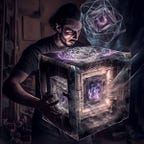What is Algorithmic Art?
Algorithmic art is a field of computer graphics that uses mathematical and statistical algorithms to create interesting images. This line of work has been around since the 80s when some pioneering artists started exploring the field to produce art with a more scientific approach. Today, algorithms have evolved and new Ai art has been produced by software and gaming companies as well as independent artists. You can find beautiful, artistic algorithms from all over the world in different fields: from video games to digital art and music. In this article, you’ll learn about alsa ai, explore some beautiful examples, and discover where you can discover more about the field.
Imagine a place where nothing exists but your imagination. Imagine that everything you want is possible and within reach. That’s Creativity is Reality.
Imagination is Reality is a generative art collection created by an algorithm.
To create each item, the algorithm goes through several steps. In the first step, 10000 Colors, each color is given a random, a line starts from a point on the pixel with a random direction and size. Then those colors and pixels are randomly chosen from the database. Selected in certain dimensions colors of the universe data. Every piece of Art Is unique and individual.
The second step is called Imagination, in which each piece has its own story that tells people about its creation. For example, if you look at this piece of art it will tell you that “I was born from a single point in space-time”. It means that all of these things started from one point, then they expanded into infinity until they became what they are today! This piece also tells us how our imaginations can be reality!
An artist’s work is a reflection of their imagination, so it’s only natural that the artwork has its own story.
Algorithmic art is a field of computer graphics that uses mathematical and statistical algorithms to create visual results. There are different types such as fractal, genetic, neural, and so on. Each algorithm produces a different result, and choosing the right one is what makes the difference between an amateur and an artist.
The idea behind algorithmic art is simple: you have an input and an output, but the path between them is not clear. You want something that looks like your input but is not exactly the same; something that has a similar feel or mood to it. You want something that has been transformed by an algorithm without being too obvious about it — something that feels natural yet generated on purpose by a computer program rather than created by hand by an artist.
In order to achieve this effect, you need software designed specifically for creating algorithmic artworks or at least software with enough options for tweaking parameters that would allow you to change how your output looks without having any knowledge about programming languages such as C++ or Python (both popular choices among artists).
In the end….
My experience with this project was amazing. It taught me a lot about AI and allowed me to work and reflect upon this technology with AI, which was interesting. Having an AI point of view as an unseen-to-be seen “Imagination is Reality collection”.
I’m a huge fan of algorithmic art, and I think it’s fascinating to see how an AI approaches the process of creating it. In this case, Alsa AI was given a specific set of instructions for what to do, and it produced some really interesting results.
It was also fascinating to see the results of our models, and their limitations. The fact that Alsa AI even did a few additional creations from these first results is, to me, proof that we could hope for a collaboration between AIs and humans, rather than the feared replacement.
Perhaps this might lead to more projects with Alsa Ai in the future?
If you liked this article, you can find more tools and posts on Twitter about AI.
You can follow us on Twitter @alsaai_eth, we have big community over there and we do share tools for artists and creators.
I hope you enjoyed this article — and don’t hesitate to react in the comments to tell me what you think of AI and art, or AI and society, or AI and communication.
I am also looking forward to your feedback on my article “How can an artificial intelligence (AI) help you?”. If you want to learn more about AI, feel free to check out my other articles: “Artificial Intelligence”
